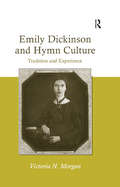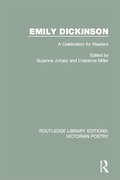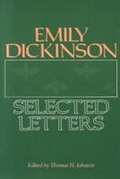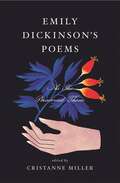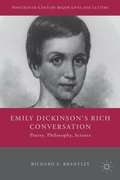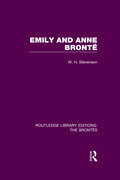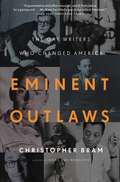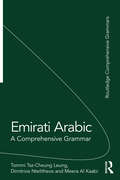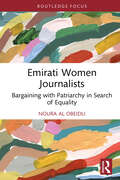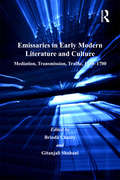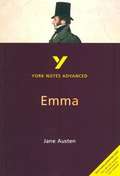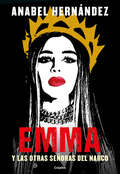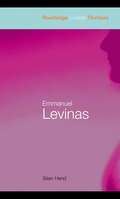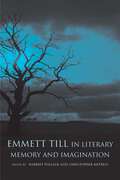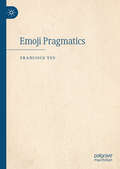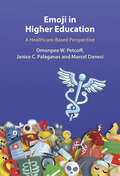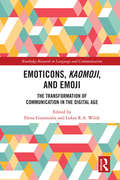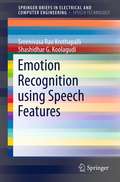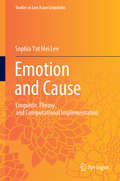- Table View
- List View
Emily Dickinson and Hymn Culture: Tradition and Experience
by Victoria N. MorganExtending the critical discussion which has focused on the hymns of Isaac Watts as an influence on Emily Dickinson's poetry, this study brings to bear the hymnody of Dickinson's female forbears and contemporaries and considers Isaac Watts's position as a Dissenter for a fuller understanding of Dickinson's engagement with hymn culture. Victoria N. Morgan argues that the emphasis on autonomy in Watts, a quality connected to his position as a Dissenter, and the work of women hymnists, who sought to redefine God in ways more compatible with their own experience, posing a challenge to the hierarchical 'I-Thou' form of address found in traditional hymns, inspired Dickinson's adoption of hymnic forms. As she traces the powerful intersection of tradition and experience in Dickinson's poetry, Morgan shows Dickinson using the modes and motifs of hymn culture to manipulate the space between concept and experience-a space in which Dickinson challenges old ways of thinking and expresses her own innovative ideas on spirituality. Focusing on Dickinson's use of bee imagery and on her notions of religious design, Morgan situates the radical re-visioning of the divine found in Dickinson's 'alternative hymns' in the context of the poet's engagement with a community of hymn writers. In her use of the fluid imagery of flight and community as metaphors for the divine, Dickinson anticipates the ideas of feminist theologians who privilege community over hierarchy.
Emily Dickinson and Philosophy
by Jed Deppman Marianne Noble Gary Lee Stonum Jed Deppman Marianne NobleEmily Dickinson's poetry is deeply philosophical. Recognizing that conventional language limited her thought and writing, Dickinson created new poetic forms to pursue the moral and intellectual issues that mattered most to her. This collection situates Dickinson within the rapidly evolving intellectual culture of her time and explores the degree to which her groundbreaking poetry anticipated trends in twentieth-century thought. Essays aim to clarify the ideas at stake in Dickinson's poems by reading them in the context of one or more relevant philosophers, including near-contemporaries such as Nietzsche, Kierkegaard and Hegel, and later philosophers whose methods are implied in her poetry, including Levinas, Sartre and Heidegger. The Dickinson who emerges is a curious, open-minded interpreter of how human beings make sense of the world – one for whom poetry is a component of a lifelong philosophical project.
Emily Dickinson and the Religious Imagination
by Linda FreedmanDickinson knew the Bible well. She was profoundly aware of Christian theology and she was writing at a time when comparative religion was extremely popular. This book is the first to consider Dickinson's religious imagery outside the dynamic of her personal faith and doubt. It argues that religious myths and symbols, from the sun-god to the open tomb, are essential to understanding the similetic movement of Dickinson's poetry - the reach for a comparable, though not identical, experience in the struggles and wrongs of Abraham, Jacob and Moses, and the life, death and resurrection of Christ. Linda Freedman situates the poet within the context of American typology, interprets her alongside contemporary and modern theology and makes important connections to Shakespeare and the British Romantics. Dickinson emerges as a deeply troubled thinker who needs to be understood within both religious and Romantic traditions.
Emily Dickinson in Context
by Eliza RichardsLong untouched by contemporary events, ideas, and environments, Emily Dickinson's writings have been the subject of intense historical research in recent years. This volume of thirty-three essays by leading scholars offers a comprehensive introduction to the contexts most important for the study of Dickinson's writings. While providing an overview of their topic, the essays also present groundbreaking research and original arguments, treating the poet's local environments; literary influences; social, cultural, political, and intellectual contexts; and reception. A resource for scholars and students of American literature and poetry in English, the collection is an indispensable contribution to the study not only of Dickinson's writings but also of the contexts for poetic production and circulation more generally in the nineteenth-century United States.
Emily Dickinson: A Celebration for Readers (Routledge Library Editions: Victorian Poetry #3)
by Suzanne Juhasz Cristanne MillerThe focus of this title, first published in 1989, begins with Dickinson’s poems themselves and the ways in which we read them. There are three readings for each of the six poems under consideration that are both complementary and provocative. The selected poems show Dickinson speaking of herself in increasingly wider relationships – to love, the outside world, death and eternity – and are grouped together to reveal her overlapping attitudes and feelings. Other topics discussed range from general epistemological and critical considerations to the poet’s self-identification and the process of reading her poetry as a feminist critic. This title will be of interest to students of literature.
Emily Dickinson: Selected Letters
by Emily Dickinson Thomas H. JohnsonThe text of these selections derives from 'The Letters of Emily Dickinson' and provides crucial texts for the appreciation of American literature, women's experience in the nineteenth century, and literature in general.
Emily Dickinson’s Poems: As She Preserved Them
by Emily DickinsonWidely considered the definitive edition of Emily Dickinson’s poems, this landmark collection presents her poems here for the first time “as she preserved them,” and in the order in which she wished them to appear. It is the only edition of Dickinson’s complete poems to distinguish clearly those she took pains to copy carefully onto folded sheets in fair hand—presumably to preserve them for posterity—from the ones she kept in rougher form. It is also unique among complete editions in presenting the alternate words and phrases Dickinson chose to use on the copies of the poems she kept, so that we can peer over her shoulder and see her composing and reworking her own poems.The world’s foremost scholar of Emily Dickinson, Cristanne Miller, guides us through these stunning poems with her deft and unobtrusive notes, helping us understand the poet’s quotations and allusions, and explaining how she composed, copied, and circulated her poems. Miller’s brilliant reordering of the poems transforms our experience of them.A true delight, this award-winning collection brings us closer than we have ever been to the writing practice of one of America’s greatest poets. With its clear, uncluttered page and beautiful production values, it is a gift for students of Emily Dickinson and for anyone who loves her poems.
Emily Dickinson’s Rich Conversation
by Richard E. BrantleyEmily Dickinson's Rich Conversation: Poetry, Philosophy, Science is a comprehensive account of Emily Dickinson's aesthetic and intellectual life. Through her letters and poems, Richard E. Brantley identifies Dickinson's dialogue with John Locke's rational empiricism, Charles Darwin's evolutionary biology, Wordsworth's 'natural methodism,' Ralph Waldo Emerson's idealism, and European and American intellectual traditions. Contrary to the image of the isolated poet, this ambitious study reveals Dickinson's agile mind developing through conversation with a community of contemporaries.
Emily and Anne Brontë (Routledge Library Editions: The Brontës)
by W. H. StevensonFrom the claustrophobic environment of Haworth Parsonage emerged an astonishing range and diversity of character and talent. Between them the two youngest Brontë sisters wrote three novels, each sharply individual in style, purpose and subject-matter. The title, first published in 1968, discusses and illustrates the similarities and differences in the writings of Emily and Anne Brontë, paying particular attention to their place in the development of the Victorian novel. He stresses the complexities of structure and characterisation in Wuthering Heights, introducing the reader first to the background of the novel. This book will be of interest to students of English Literature.
Emily's Surprise (Rigby Leveled Library, Level K #33)
by Debbie Croft Vicky FieldhouseNIMAC-sourced textbook
Eminent Outlaws: The Gay Writers Who Changed America
by Christopher BramIn the years following World War II, a small group of gay writers established themselves as literary power players, fueling cultural changes that would resonate for decades to come, and transforming the American literary landscape forever. In EMINENT OUTLAWS, novelist Christopher Bram brilliantly chronicles the rise of gay consciousness in American writing. Beginning with a first wave of major gay literary figures-Tennessee Williams, Gore Vidal, Truman Capote, Allen Ginsberg, and James Baldwin-he shows how (despite criticism and occasional setbacks) these pioneers set the stage for new generations of gay writers to build on what they had begun: Armistead Maupin, Edmund White, Tony Kushner, and Edward Albee among them.Weaving together the crosscurrents, feuds, and subversive energies that provoked these writers to greatness, EMINENT OUTLAWS is a rich and essential work. With keen insights, it takes readers through fifty years of momentous change: from a time when being a homosexual was a crime in forty-nine states and into an age of same-sex marriage and the end of Don't Ask, Don't Tell.
Emirati Arabic: A Comprehensive Grammar (Routledge Comprehensive Grammars)
by Tommi Tsz-Cheung Leung Dimitrios Ntelitheos Meera Al KaabiEmirati Arabic: A Comprehensive Grammar offers readers a reference tool for discovering and studying in detail the specific dialect of Arabic spoken in the United Arab Emirates. It covers all major areas of Emirati Arabic grammar, describing in detail its phonological, morphological, syntactic, and semantic systems. Each grammatical point is illustrated with numerous examples drawn from native Emirati Arabic speakers and is thoroughly discussed providing both accessible and linguistically informed grammatical description. This book is a useful reference for students of Gulf Arabic and/or Modern Standard Arabic or other Arabic dialects with an interest in the dialect spoken in the UAE, researchers interested in Arabic language and linguistics as well as graduate students and scholars interested in Arabic studies.
Emirati Women Journalists: Bargaining with Patriarchy in Search of Equality (Routledge Focus on Journalism Studies)
by Noura Al ObeidliThis book presents a rare investigation of the media landscape and gender dynamics in Emirati newsrooms, with a socio-cultural focus on the influence of tribal patriarchalism in determining Emirati women’s role as newsmakers.Shedding light on the stories of 40 Emirati and Arab expat journalists, including pioneer Emirati women journalists, the book offers insight into how these journalists construct gender differences and identity and how this influences their everyday attitudes, conversations, routines, and journalistic practices. The empirical study is supplanted with ethnographic explanations of the newsroom norms and journalistic practices from the author, who used participant observation inside two major news centres in Abu Dhabi and Dubai to understand the socio-cultural factors that shape the lives of Emirati and Arab expat journalists, their thoughts and beliefs about the media environment in the Emirates, and their opinions on authoritarian political control, censorship, and outdated media law.This book will interest students and scholars of journalism and journalistic practice, media policy, international journalism, gender studies, and Middle East studies.
Emissaries in Early Modern Literature and Culture: Mediation, Transmission, Traffic, 1550–1700 (Transculturalisms, 1400-1700)
by Gitanjali ShahaniWith its emphasis on early modern emissaries and their role in England's expansionary ventures and cross-cultural encounters across the globe, this collection of essays takes the messenger figure as a focal point for the discussion of transnational exchange and intercourse in the sixteenth and seventeenth centuries. It sees the emissary as embodying the processes of representation and communication within the world of the text, itself an 'emissary' that strives to communicate and re-present certain perceptions of the 'real.' Drawing attention to the limits and licenses of communication, the emissary is a reminder of the alien quality of foreign language and the symbolic power of performative gestures and rituals. Contributions to this collection examine different kinds of cross-cultural activities (e.g. diplomacy, trade, translation, espionage, missionary endeavors) in different world areas (e.g. Asia, the Mediterranean, the Levant, the New World) via different critical methods and approaches. They take up the literary and cultural productions and representations of ambassadors, factors, traders, translators, spies, middlemen, merchants, missionaries, and other agents, who served as complex conduits for the global transport of goods, religious ideologies, and socio-cultural practices throughout the early modern period. Authors in the collection investigate the multiple ways in which the emissary became enmeshed in emerging discourses of racial, religious, gender, and class differences. They consider how the emissary's role might have contributed to an idealized progressive vision of a borderless world or, conversely, permeated and dissolved borders and boundaries between peoples only to further specific group interests.
Emma (MAXNotes Literature Guides)
by Jean HartREA's MAXnotes for Jane Austen's Emma MAXnotes offer a fresh look at masterpieces of literature, presented in a lively and interesting fashion. Written by literary experts who currently teach the subject, MAXnotes will enhance your understanding and enjoyment of the work. MAXnotes are designed to stimulate independent thought about the literary work by raising various issues and thought-provoking ideas and questions. MAXnotes cover the essentials of what one should know about each work, including an overall summary, character lists, an explanation and discussion of the plot, the work's historical context, illustrations to convey the mood of the work, and a biography of the author. Each chapter is individually summarized and analyzed, and has study questions and answers.
Emma (SparkNotes Literature Guide Series)
by SparkNotesEmma (SparkNotes Literature Guide) by Jane Austen Making the reading experience fun! Created by Harvard students for students everywhere, SparkNotes is a new breed of study guide: smarter, better, faster.Geared to what today's students need to know, SparkNotes provides:chapter-by-chapter analysis explanations of key themes, motifs, and symbols a review quiz and essay topics Lively and accessible, these guides are perfect for late-night studying and writing papers.
Emma - Notes
by Jane Austen edited by COLES EDITORIAL BOARDThe novel deals with one community, several families the two major characters - Emma Woodhouse and Knightley. The story reveals their friendship over 17 years the courtship that leads to their marriage. Intertwined with this simple story are the issues of marriage and freedom of choice, class consciousness and snobbery, morality, the evils of self-love and self-deception, and the consciousness of women.
Emma y las otras señoras del narco
by Anabel HernándezEste libro forma parte del largo recorrido periodístico de Anabel Hernández dentro del complejo mundo del crimen organizado en México, así como de su incesante búsqueda por entender los diversos componentes de los cárteles de la droga, los cuales tienen sumida a la nación desde hace décadas en una espiral de violencia en la que todos los días son explotadas, desaparecidas o asesinadas decenas de personas inocentes, muchas de ellas del sexo femenino. Desde su bestseller Los señores del narco (2010), éste es quizás el acercamiento más íntimo a la cúpula del narcotráfico, un detrás de cámaras de lo que ocurre en el multimillonario negocio criminal. En Emma y las otras señoras del narco la autora recorre el velo y muestra las pulsiones más profundas que hacen a los narcos buscar poder y dinero a toda costa. La autora de El traidor (2019), multigalardonada y reconocida internacionalmente como experta en temas de narcotráfico, una vez más gira la mesa del tablero y ofrece al lector un análisis casi antropológico de los capos de la droga y su entorno más cercano desde una nueva óptica: el mundo de sus mujeres. En estas páginas desfilan personajes como Emma Coronel y otras esposas de importantes narcotraficantes, una ex Miss Universo, y algunas de las actrices, cantantes y conductoras de televisión más reconocidas y aplaudidas en México, tanto del pasado como de la época actual. Madres, esposas y amantes. Mujeres que se amoldan a las reglas machistas de sus amos y bailan ante ellos -en privado, fiestas u orgías- la danza de los siete velos, y lo hacen sobre los cadáveres de los miles que han sido víctimas de los mismos hombres a quienes deleitan con su cómplice presencia a cambio de dinero, joyas y propiedades. Con el rigor investigativo que la caracteriza, Anabel Hernández, a través de entrevistas realizadas a testigos de los hechos, lleva al lector a las reuniones familiares, fiestas y alcobas de diversos narcotraficantes donde ocurren las historias de amor, compra y venta de placer, incesto, ambición, traición y venganza. Un mundo hasta ahora desconocido.
Emmanuel Levinas (Routledge Critical Thinkers)
by Seán HandBest known for his theories of ethics and responsibility, Emmanuel Levinas was one of the most profound and influential thinkers of the last century. In this clear, accessible guide, Seán Hand examines why Levinas is increasingly fundamental to the study of literature and culture today. Exploring the intellectual and social contexts of his work and the events that shaped it, Hand considers: the influence of phenomenology and Judaism on Levinas’s thought key concepts such as the ‘face’, the ‘other’, ethical consciousness and responsibility Levinas’s work on aesthetics the relationship of philosophy and religion in his writings the interaction of his work with historical discussions his often complex relationships with other theorists and theories Emmanuel Levinas’s unique contribution to theory set an exemplary standard for all subsequent thought. This outstanding guide to his work will prove invaluable to scholars and students across a wide range of disciplines - from philosophy and literary criticism through to international relations and the creative arts.
Emmett Till in Literary Memory and Imagination: New and Selected Poems (Southern Literary Studies)
by Harriet Pollack Christopher MetressThe horrific 1955 slaying of fourteen-year-old Emmett Till marks a significant turning point in the history of American race relations. An African American boy from Chicago, Till was visiting relatives in the Mississippi Delta when he was accused of "wolf-whistling" at a young white woman. His murderers abducted him from his great-uncle's home, beat him, then shot him in the head. Three days later, searchers discovered his body in the Tallahatchie River. The two white men charged with his murder received a swift acquittal from an all-white jury. The eleven essays in Emmett Till in Literary Memory and Imagination examine how the narrative of the Till lynching continues to haunt racial consciousness and to resonate in our collective imagination.The trial and acquittal of Till's murderers became, in the words of one historian, "the first great media event of the civil rights movement," and since then, the lynching has assumed a central place in literary memory. The international group of contributors to this volume explores how the Emmett Till story has been fashioned and refashioned in fiction, poetry, drama, and autobiography by writers as diverse as William Bradford Huie, James Baldwin, Langston Hughes, Gwendolyn Brooks, Audre Lorde, Anne Moody, Nicolás Guillén, Aimé Césaire, Bebe Moore Campbell, and Lewis Nordan. They suggest the presence of an "Emmett Till narrative" deeply embedded in post-1955 literature, an overarching recurrent plot that builds on recognizable elements and is as legible as the "lynching narrative" or the "passing narrative." Writers have fashioned Till's story in many ways: an the annotated bibliography that ends the volume discusses more than 130 works that memorialize the lynching, calling attention to the full extent of Till's presence in literary memory. Breaking new ground in civil rights studies and the discussion of race in America, Emmett Till in Literary Memory and Imagination eloquently attests to the special power and artistic resonance of one young man's murder.
Emoji Pragmatics
by Francisco YusEmoji is everywhere—on messaging apps, social networking sites, and even in offline media like billboards, films, and printed ads. While there is a substantial existing bibliography on emojis, it often fails to address their functions and interpretations in purely pragmatic terms, specifically focusing on their impact on inferential strategies for both the emojis themselves and accompanying texts. Existing books on this topic tend to focus on the semiotic aspects or visual impact of emojis, rather than their crucial role in interpreting the messaging text or social media post to which they are attached, as well as the way they communicate their own meanings when used in isolation (so-called naked emojis). This book is original in analysing the pragmatic roles that emojis play in online communication, the additional information they convey, and the role of context in their successful interpretation. The book also argues that, despite the apparent differences between words and images, emojis perform similar functions and are inferred in similar ways to words, with the aid of context. Additionally, the book dedicates several chapters to demographic variables (age, gender, ethnic origin, personality, etc.), the role of “interface affordances” in emoji use, and thematic areas where emojis are frequently found: humour, advertising/marketing, politics, law, and health.
Emoji in Higher Education: A Healthcare-Based Perspective
by Omonpee W. Petcoff Janice C. Palaganas Marcel DanesiEmoji are a significant development in contemporary communication, deserving serious attention for their impact on both language use and society. Based on original mixed-methods research, this timely book focuses on emoji literacy across the healthcare landscape, with emphasis on how they are employed in healthcare worker and patient education. It situates emoji within a semioliteracy theoretical framework and presents the findings of a mixed methods study of emoji use as a literacy tool in a health professions course. Drawing on real-life case studies, it explores emoji literacy across a range of public health education contexts including doctor-to-industry, patient-to doctor, doctor-to-patient, and healthcare providers/CDC to global audience. It also advances a broader argument about the role of emoji in a paradigm shift of communication in education. This title is part of the Flip it Open Programme and may also be available Open Access. Check our website Cambridge Core for details.
Emoticons, Kaomoji, and Emoji: The Transformation of Communication in the Digital Age (Routledge Research in Language and Communication)
by Elena Giannoulis Lukas R.A. WildeThis collection offers a comprehensive treatment of emoticons, kaomoji, and emoji, examining these digital pictograms and ideograms from a range of perspectives to comprehend their increasing role in the transformation of communication in the digital age. Featuring a detailed introduction and eleven contributions from an interdisciplinary group of scholars, the volume begins by outlining the history and development of the field, situating emoticons, kaomoji, and emoji – expressing a variety of moods and emotional states, facial expressions, as well as all kinds of everyday objects– as both a topic of global relevance but also within multimodal, semiotic, picture theoretical, cultural and linguistic research. The book shows how the interplay of these systems with text can alter and shape the meaning and content of messaging and examines how this manifests itself through different lenses, including the communicative, socio-political, aesthetic, and cross-cultural. Making the case for further study on emoticons, kaomoji, and emoji and their impact on digital communication, this book is key reading for students and scholars in sociolinguistics, media studies, Japanese studies, and language and communication.
Emotion Recognition using Speech Features
by K. Sreenivasa Rao Shashidhar G. Koolagudi"Emotion Recognition Using Speech Features" provides coverage of emotion-specific features present in speech. The author also discusses suitable models for capturing emotion-specific information for distinguishing different emotions. The content of this book is important for designing and developing natural and sophisticated speech systems. In this Brief, Drs. Rao and Koolagudi lead a discussion of how emotion-specific information is embedded in speech and how to acquire emotion-specific knowledge using appropriate statistical models. Additionally, the authors provide information about exploiting multiple evidences derived from various features and models. The acquired emotion-specific knowledge is useful for synthesizing emotions. Features includes discussion of: * Global and local prosodic features at syllable, word and phrase levels, helpful for capturing emotion-discriminative information; * Exploiting complementary evidences obtained from excitation sources, vocal tract systems and prosodic features in order to enhance the emotion recognition performance; * Proposed multi-stage and hybrid models for improving the emotion recognition performance. This brief is for researchers working in areas related to speech-based products such as mobile phone manufacturing companies, automobile companies, and entertainment products as well as researchers involved in basic and applied speech processing research.
Emotion and Cause: Linguistic Theory and Computational Implementation (Studies in East Asian Linguistics)
by Sophia Yat LeeThis work argues that cause events, being the most tangible component of emotion, provide a rich dimension of how emotions should be classified. While it is often claimed that emotional concepts cannot be defined, this work views emotion as a response triggered by actual or perceived events, specifically focusing on the interaction between five primary emotions (Happiness, Sadness, Fear, Anger, and Surprise) and cause events. Cause events are examined in terms of two dimensions, namely transitivity and epistemicity. By incorporating the semantic and syntactic information of emotion cause events, this representation of emotion not only provides deep linguistic criteria of emotion cause events, but also offers an event-based approach to emotion classification. A text-driven, rule-based system for detecting the causes of emotion is then developed to establish the validity of the proposed linguistic model for emotion detection and classification. The system shows promising results.
